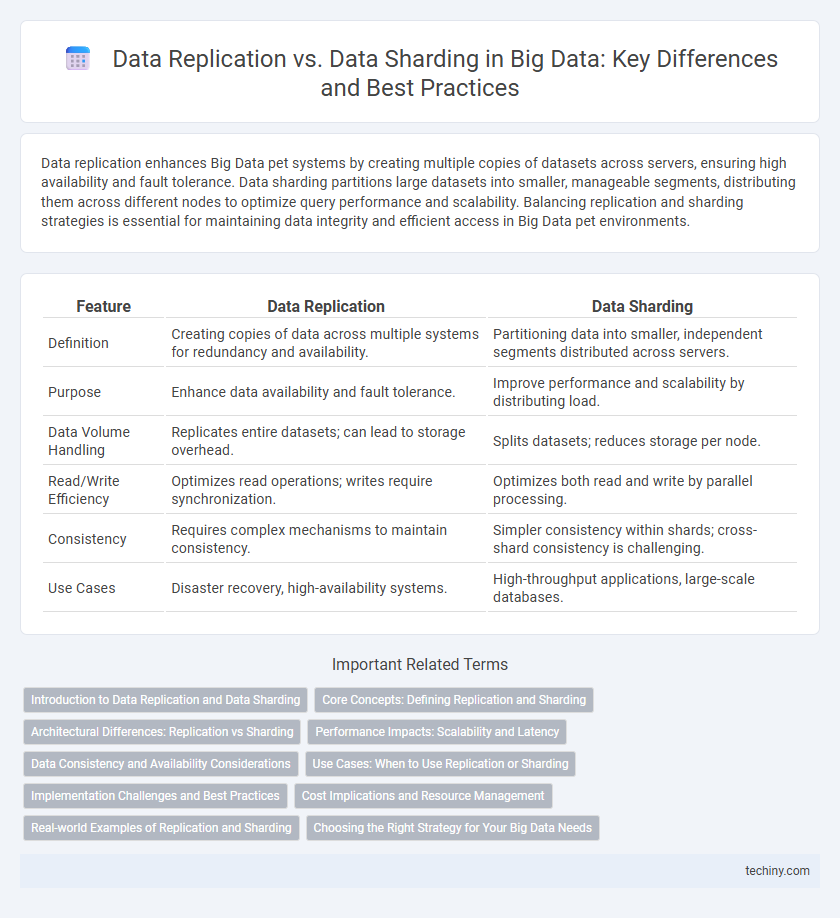Data replication enhances Big Data pet systems by creating multiple copies of datasets across servers, ensuring high availability and fault tolerance. Data sharding partitions large datasets into smaller, manageable segments, distributing them across different nodes to optimize query performance and scalability. Balancing replication and sharding strategies is essential for maintaining data integrity and efficient access in Big Data pet environments.
Table of Comparison
| Feature | Data Replication | Data Sharding |
|---|---|---|
| Definition | Creating copies of data across multiple systems for redundancy and availability. | Partitioning data into smaller, independent segments distributed across servers. |
| Purpose | Enhance data availability and fault tolerance. | Improve performance and scalability by distributing load. |
| Data Volume Handling | Replicates entire datasets; can lead to storage overhead. | Splits datasets; reduces storage per node. |
| Read/Write Efficiency | Optimizes read operations; writes require synchronization. | Optimizes both read and write by parallel processing. |
| Consistency | Requires complex mechanisms to maintain consistency. | Simpler consistency within shards; cross-shard consistency is challenging. |
| Use Cases | Disaster recovery, high-availability systems. | High-throughput applications, large-scale databases. |
Introduction to Data Replication and Data Sharding
Data replication involves creating and maintaining copies of data across multiple nodes or servers to ensure high availability, fault tolerance, and improved read performance in big data systems. Data sharding, also known as horizontal partitioning, refers to distributing subsets of data across different database servers or nodes based on a shard key, optimizing write scalability and reducing query load. Both techniques play crucial roles in managing large-scale distributed databases by enhancing system reliability and performance through different architectural approaches.
Core Concepts: Defining Replication and Sharding
Data replication involves creating exact copies of data across multiple servers to ensure high availability and fault tolerance, minimizing downtime and data loss. Data sharding partitions a large dataset into smaller, more manageable pieces or shards, each stored on separate database servers to improve performance and scalability. Both techniques address different challenges in big data management: replication enhances reliability, while sharding boosts efficiency in handling massive volumes of data.
Architectural Differences: Replication vs Sharding
Data replication involves copying and maintaining identical data across multiple nodes to ensure high availability and fault tolerance, while data sharding partitions data into smaller, manageable segments distributed across different nodes for improved scalability and performance. Replication emphasizes redundancy and data consistency, often using synchronous or asynchronous methods, whereas sharding focuses on horizontal scaling by dividing datasets based on shard keys or ranges. Architecturally, replication maintains complete data sets on each node, while sharding distributes unique subsets of the data, impacting query routing and overall system complexity.
Performance Impacts: Scalability and Latency
Data replication enhances scalability by creating multiple copies of data across servers, reducing read latency and ensuring high availability during peak loads. In contrast, data sharding partitions the database into smaller, manageable segments, distributing workloads and improving write performance while potentially increasing latency for cross-shard queries. Balancing replication and sharding strategies optimizes big data system performance by minimizing latency and maximizing throughput in large-scale environments.
Data Consistency and Availability Considerations
Data replication enhances availability by duplicating data across multiple nodes, ensuring continuous access during failures but requires strong consistency protocols to prevent conflicting updates. Data sharding improves scalability and performance by partitioning datasets into smaller, manageable pieces, yet poses challenges for maintaining consistency across distributed shards. Balancing consistency and availability depends on the system's architecture and use case, often employing consensus algorithms like Paxos or Raft to synchronize replicated data while shards rely on careful shard key design to minimize cross-shard transactions.
Use Cases: When to Use Replication or Sharding
Data replication is ideal for applications requiring high availability and fault tolerance, such as online transaction processing (OLTP) systems, where data consistency and quick recovery are critical. Data sharding is best suited for large-scale, distributed databases needing horizontal scalability and efficient query performance, like social media platforms handling massive user-generated content. Choosing replication or sharding depends on workload patterns, consistency requirements, and system architecture demands.
Implementation Challenges and Best Practices
Data replication faces implementation challenges such as increased storage costs and maintaining consistency across multiple nodes, requiring best practices like synchronous replication and conflict resolution mechanisms. Data sharding demands careful partitioning to avoid data hotspots and balance load, with best practices including consistent hashing and dynamic resharding strategies. Both approaches benefit from robust monitoring tools and automation to ensure scalability and fault tolerance in big data environments.
Cost Implications and Resource Management
Data replication increases storage costs due to multiple copies of datasets but enhances data availability and fault tolerance, optimizing resource allocation for read-heavy workloads. In contrast, data sharding reduces storage overhead by distributing data across shards, lowering infrastructure expenses and improving write performance, though it requires intricate resource management and coordination. Choosing between replication and sharding depends on balancing budget constraints with performance needs, emphasizing efficient utilization of computational and storage resources.
Real-world Examples of Replication and Sharding
Data replication is commonly used in financial services like stock trading platforms where continuous data availability and fault tolerance are critical, ensuring real-time transaction consistency across multiple data centers. In contrast, sharding is widely implemented by large-scale web services such as social media platforms, where user data is distributed across different shards to enhance query performance and enable horizontal scaling. Amazon DynamoDB leverages sharding to manage massive volumes of user requests, while Netflix employs data replication to maintain high availability and disaster recovery across regions.
Choosing the Right Strategy for Your Big Data Needs
Data replication enhances fault tolerance and data availability by creating exact copies across multiple nodes, making it ideal for read-heavy workloads requiring high reliability. Data sharding distributes large datasets horizontally into smaller, more manageable partitions, improving write performance and scalability for massive, rapidly growing databases. Selecting between replication and sharding depends on workload characteristics, consistency requirements, and system architecture to optimize performance and resource utilization in big data environments.
Data Replication vs Data Sharding Infographic

 techiny.com
techiny.com